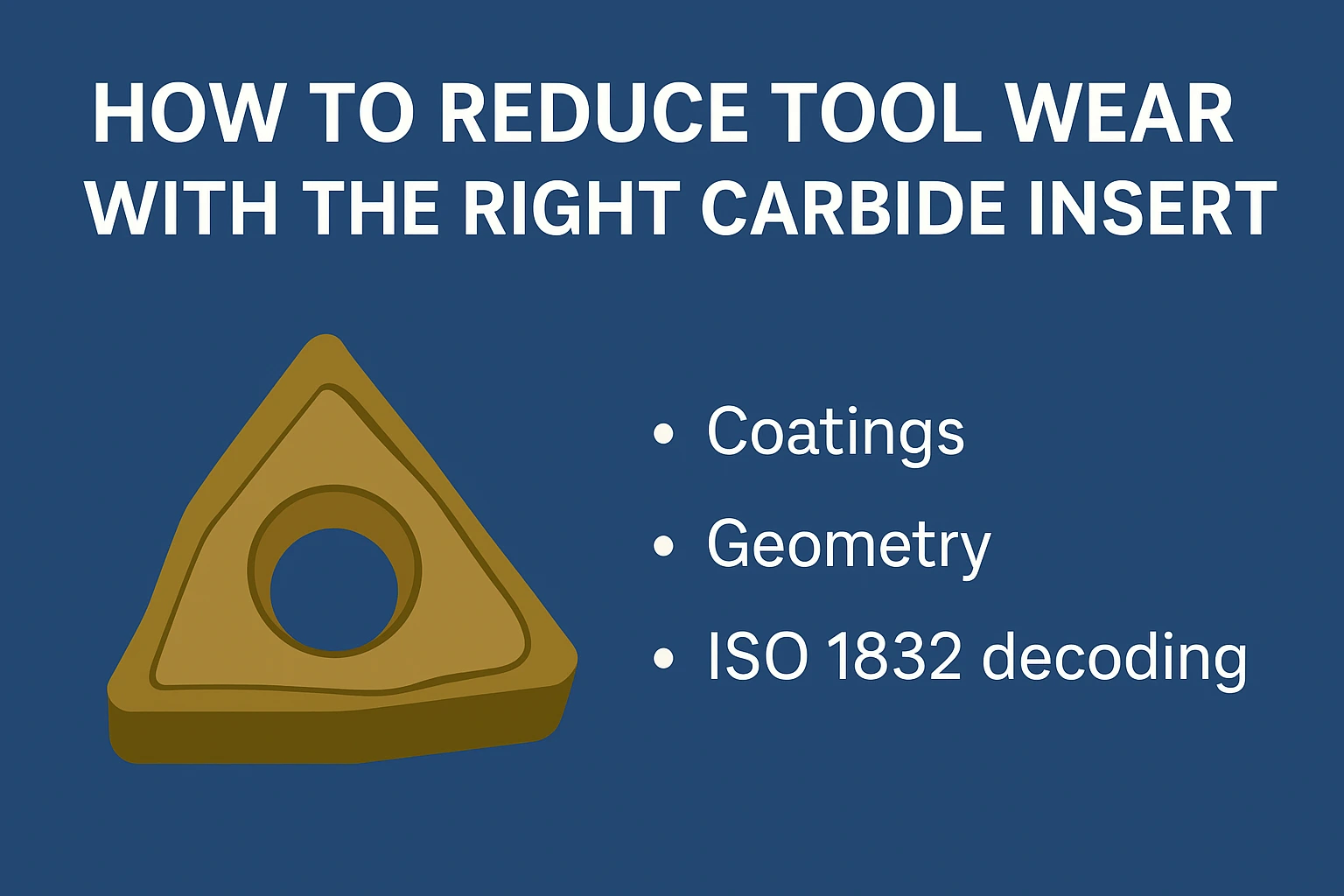How to Reduce Tool Wear with the Right Carbide Insert
Learn how to reduce tool wear with the right carbide inserts. Understand ISO 1832 nomenclature, coatings, chipbreakers, and shop-proven tips from CNC Tools Depot.

CNC Tools Depot is the world’s largest marketplace for carbide inserts, stocking all leading global brands including Sandvik Coromant, Kennametal, Iscar, Korloy, Kyocera, Mitsubishi, Widia, TaeguTec, and more. We specialize in providing machinists, engineers, and manufacturers with a one-stop destination for high-performance CNC cutting tools.
Our mission is simple: to make it easier for industries ranging from automotive and aerospace to die & mold and general machining to find the right turning inserts, milling inserts, and threading tools—backed by verified manufacturer datasheets, ISO 1832 standard nomenclature, and expert technical guidance.
By combining trusted brands, deep technical expertise, and reliable global sourcing, CNC Tools Depot helps customers reduce tool wear, improve productivity, and maximize cost-efficiency in metal cutting operations.
What a carbide insert is
An indexable carbide insert is a replaceable cutting tip (cemented carbide ± coating) designed to be mounted into a toolholder for turning, milling or drilling. Inserts separate the expensive cutting geometry (the replaceable tip) from the holder, allowing fast indexing and consistent geometry across many parts — a core reason they reduce cost and downtime in CNC cutting tools. For material- and operation-specific performance, manufacturers pair a substrate grade (carbide mix), edge prep, chipbreaker and coating into a product system.
ISO 1832 — how to read an insert code
ISO 1832 defines the designation system for indexable inserts (shape, clearance, tolerance, type, IC/size, thickness, nose radius and more). When you see a code like CNMG 120408, the positions communicate essential selection data so you pick the correct insert for wear resistance and strength.
Decode: CNMG 120408 — practical breakdown (example):
- C — Insert shape: 80° rhombic/diamond (good for facing and general turning).
- N — Clearance (relief) angle:
N = 0°(often called “negative” — stronger edge, indexable both sides). - M — Tolerance class:
M= medium / molded tolerance (vsG= ground/tighter tolerance). Tolerance affects fit in the seat. - G — Type / chipbreaker / hole style: indicates cross-section/profile and hole/chipbreaker style (many manufacturers append further letters to describe chipbreaker and grade).
- 12 — Inscribed Circle (IC) ≈ 12.7 mm (size code).
- 04 — Thickness (e.g., 4.76 mm).
- 08 — Nose radius (0.8 mm).
Short checklist: when you read any ISO insert code, start with shape & clearance (first 2 letters) → check tolerance/type (letters 3–4) → confirm IC, thickness and nose radius (the numbers). Use the manufacturer datasheet to match the brand’s chipbreaker and grade suffixes.
Step-by-step: Choose the right insert to reduce tool wear
Below are practical levers you can change — with plain-language explanation and shop-level prescriptions.
1) Shape & clearance angle — match access vs strength
- Choose shape for accessibility and strength. Diamond (C, D, V) shapes give access in shoulder/facing; square/round shapes are stronger for heavy cuts. A 80° diamond (C) is common for general turning; a 55° (D) or 35° (V) may be used for special profiles.
- Clearance (relief) angle: negative (0°,
N) gives stronger edge for roughing; positive (e.g., 7°C) gives freer cutting and lower cutting forces for finishing. Match clearance to operation to avoid rubbing (which increases flank wear).
2) Grade & coating — PVD vs CVD (big effect on wear)
- PVD coatings (e.g., TiN, TiCN, TiAlN in thin multilayers) are applied at lower temperatures and produce thin, hard coatings that preserve a sharp edge — excellent for finishing and when edge sharpness reduces cutting forces. Sandvik explains PVD’s low-temperature process and hardness benefits.
- CVD coatings are thicker and act as better thermal and abrasion barriers; they allow higher cutting speeds in some steels and cast irons but require a tougher substrate because CVD is applied at higher temperatures. Kennametal and industry guides document when CVD is preferable (higher speeds, abrasion resistance) vs PVD (edge toughness, finishing).
Shop rule: Use a PVD-coated fine-grade for finishing stainless and steels when edge sharpness matters; choose CVD-coated or thick-coated grades for high-speed, abrasive jobs (cast iron, heavy roughing). Always consult the maker’s grade chart.
3) Chipbreaker — control chips to control heat & wear
- Function: chipbreakers curl and subdivide chips; good chip control prevents chip re-cutting, clogging, and local heating that accelerates crater and flank wear. Choose a chipbreaker matched to feed and depth of cut.
Tip: If you have long stringy chips or poor evacuation, try a chipbreaker designed for that material (manufacturers provide chipbreaker maps). Proper feed and DOC are required to activate the chipbreaker groove.
4) Nose radius & edge preparation — balance finish vs edge strength
- Nose radius: larger radius → stronger edge and often better tool life and surface finish at higher feeds, but increases radial cutting force (may promote vibration if machine/part is not rigid). Smaller radius → lower cutting forces, better for thin walls and light finishing. Aim for nose radius ≤ depth-of-cut; matching radius to DOC helps reduce notch wear.
- Edge prep / honing: a small hone (rounded edge) or T-land strengthens the edge and reduces micro-chipping; many modern inserts offer engineered edge preps that significantly extend life. Scientific and manufacturer data show honed edges reduce crack initiation and improve wear resistance.
Rule of thumb: For interrupted or tough cuts, use a honed/T-land edge; for ultra-finish cuts use a sharper, smaller hone or cermet grades.
5) Toolholding, clamping & runout — mechanical basics that kill inserts if ignored
- Seat cleanliness & correct clamping torque: a dirty seat or under/over tightened clamp changes contact geometry and causes uneven loading and chipping. Clean the seat and use a torque wrench where specified.
- Minimize runout & overhang: excessive radial runout concentrates wear on one corner. Shorten overhang and use rigid holders and shrink/hydro chucks for milling where possible.
6) Cutting data, coolant and machining strategy — control heat & time in cut
- Optimize speed/feed/depth: too low speed → built-up edge (adhesive wear); too high speed → rapid flank/crater wear. Manufacturers publish recommended ranges for each grade — start there and adjust for stability and finish.
- Coolant / MQL / through-tool coolant: coolant reduces temperature and can prolong tool life especially in steel and difficult materials; for some operations (ceramics, CBN) coolant choices differ — follow manufacturer guidance.
- Distribute wear: index inserts periodically and, when possible, choose wiper geometries to raise feed without increasing flank wear for finishes.
7) Monitoring, inspection & preventive practices
- Inspect edges regularly (flank/crater wear, chipping, notch wear) and log tool life per operation. Use images or simple tools (10× loupe) to document wear progression — this helps tune cutting data and select a better grade. Sandvik and Kennametal troubleshooting guides give remedies tied to observed wear modes.
Sandvik vs Iscar vs Kennametal (neutral)
- Sandvik Coromant: deep knowledge base, many specialized grades and tooling systems, strong technical guides for coatings and troubleshooting. Good resource for aerospace and high-productivity steels.
- Iscar: wide range of proprietary grades and chipbreaker designs; strong on grooving/parting and innovative grade/coating combos. Use Iscar grade charts when part geometry requires unique chipforming.
- Kennametal: broad portfolio, emphasis on post-coat treatment and grade consistency; strong tooling systems and application support for automotive and heavy industry.
How to compare: map the exact workpiece material + operation to each maker’s grade chart and chipbreaker map — then test one insert family at the recommended cutting data. Manufacturer application charts are the fastest path to reduce trial-and-error.
Practical applications
- Automotive: crankshafts, transmission parts — needs consistent tool life at volume; choose robust grades and tight tolerance (ground) inserts.
- Aerospace: titanium, superalloys — specialty PVD/CVD and ceramic grades, careful strategy to control heat & vibration.
- Die & mold / general machining: diverse steels and stainless jobs — mix of PVD grades for finishing and CVD for heavy, abrasive cuts.
Quick shop-floor checklist to cut tool wear (one-line actionable items)
- Clean the insert seat before mounting (no chips).
- Match insert shape & clearance to the operation (C/N for general, D for special angles).
- Use manufacturer grade/coating recommendations for the workpiece material (P, M, K, N categories).
- Set speeds/feeds to manufacturer starting values; adjust for temperature and vibration.
- Choose chipbreaker that suits feed & DOC to avoid long chips and re-cutting.
- Use proper edge prep for interrupted or heavy cuts (hone/T-land).
- Minimize runout; shorten overhang; maintain toolholder and torque to spec.
Frequently Asked Questions
CNMG is an ISO-style code. C = 80° rhombic/diamond shape, N = 0° (negative) relief, M = medium tolerance, G = type/profile (hole/chipbreaker style); numbers after (e.g., 12 04 08) show IC, thickness and nose radius. Always check the manufacturer datasheet for exact geometry.
For stainless, many shops use a PVD-coated carbide with a fine-grain substrate to reduce built-up edge (BUE). Choose a chipbreaker that avoids long chips and a grade designed for “sticky” materials. Manufacturer grade charts (Sandvik/Kennametal/Iscar) list recommended grades.
Read left-to-right: shape → clearance → tolerance → type/profile → IC(size) → thickness → nose radius. The first 4 letters define geometry; the numeric group the dimensions. Use ISO 1832 or your supplier’s designation key to decode.
PVD = thinner, low-temp deposition, keeps sharp edges — favors finishing and edge toughness. CVD = thicker coating, better thermal/abrasion barrier — can enable higher cutting speeds in some steels and cast irons but needs a compatible substrate. Pick by material & operation.
CNC Tools Depot stocks leading brands (Sandvik, Kennametal, Iscar, Korloy, TaeguTec, and more), provides manufacturer datasheets and ISO nomenclature help so you can choose the correct insert quickly — reducing errors and tool wear on the shop floor. (Explore product datasheets on the marketplace for side-by-side comparison.)



